You will speed product deployment, create compelling displays, and engage customers like never before with a cable management access floor!
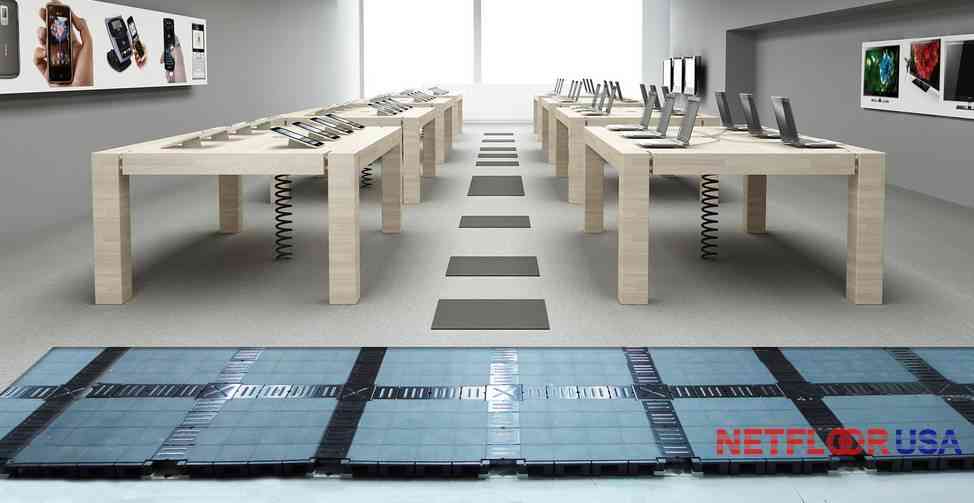
You have to make them feel something.
Your customers need to walk into your store and be wowed.
It's not just products anymore; you are selling solutions. You are selling a feeling to your customers.
You have to create those big "Ah Ha!" moments: "This service solves so many problems." And "This device will make my life way easier."
But as a store design professional, who solves your problems?
You know the ones. The problems that take up too much of your time, which you should be spending on creating eye-catching displays. Problems like how to connect and power dozens of interactive product displays while making your store look great.
Sit back, relax, and read on. We are here to help!
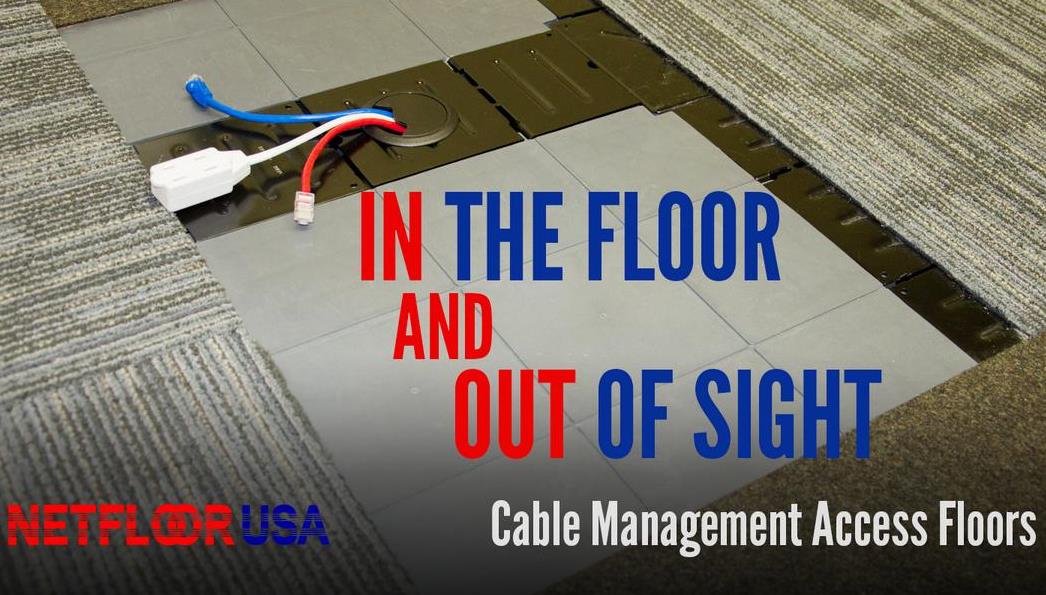
Access Floors in Retail Stores
In a blog post a while back, we wrote about access floors in technology retail stores. It was a short post that pointed out a few (but important!) reasons why the retail industry has been utilizing access floor in store designs.
Since that blog post, we have seen our low profile access floor products explode into the retail sector. So much so, we decided it deserved not just a mere blog post, but an article all to itself! (cue dramatic music!)
With that being said, why are access floors making such a big splash in retail?
Read on, and let's find out!
Simplify Cable Routing
Cable routing is quite possibly THE single most boring aspect of a retail store.
Nobody wants to do it, and most don't even know how to do it right. But, if you actually do it right, it can accelerate your deployment timeline drastically, quite possibly elevating you to hero status in the process (No guarantees, but you'll always be a hero to us!).
To really understand how cabling is so much easier with a cable management floor (as if the name "cable management floor" wasn't enough of a clue!), we wrote an entire article comparing the different menthods of running cables. It's an interesting read, if you're into that sort of thing (We are!).
But for now, let's just say this: there are several ways of running cables and wires in a building, retail stores included. Most of them are the "tried and true" method that you never realized was such a pain in the butt until something far better came along (cable management floor, if you're still wondering what we're talking about here!)
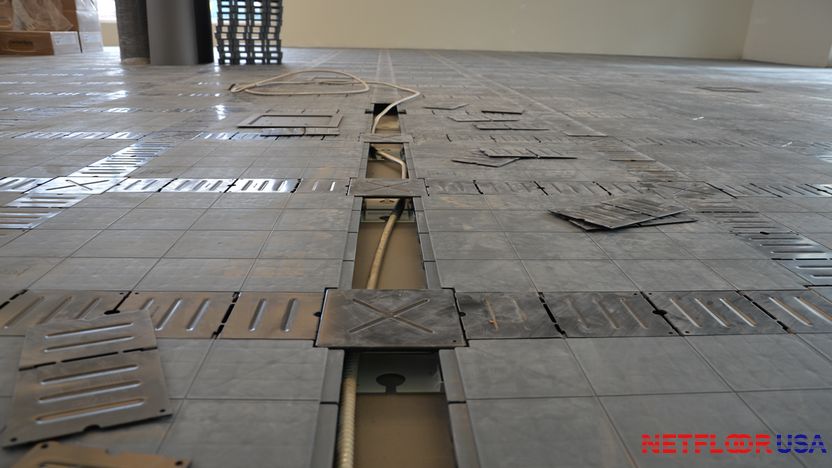
Be the forward-thinker who gets a highly-configurable access floor system installed, and never worry about re-routing cables again.
Let's play some trivia:
Which sounds easier to you: 1) pouring a concrete slab, renting a dirty, expensive and loud concrete saw to slowly cut out sections of concrete, removing the concrete, laying conduit, running cables, then pouring more concrete into the trenches...or 2) Pouring the concrete, laying our your Netfloor USA floor and running cables?
(Psssst... The answer is #2)
Still don't believe us? Let's add a monkey wrench into that scenario:
Let's say you run your cables using method #1 (concrete trenching), fill the trench back in with concrete, then oooops, corporate decides they want to completely change the store layout to bring it in line with the new COO's "vision"?
I'd hate to be that guy, and I bet you would too. So don't be him (or her), be the forward-thinker who gets a highly-configurable access floor system installed, and never worry about re-routing cables again.
Infinite Outlet and Electrical Box Locations
Why are you limiting you store layout team to creating planagrams that revolve around your cables and floor boxes? (Hint: it's probably because your subfloor has concrete trenches that can't be changed.)
And worse yet, when you do change your layout, the floor is left with ugly indentations and carpet or tile cutouts where the old power connections were. Nothing screams "outdated company" like a dirty floor missing sections of carpet or tile.
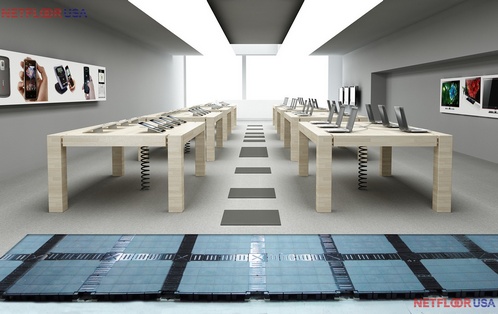
Souldn't your fixtures be laid out to maximize customer engagement? Shouldn't your product displays be right there for the customer, begging them to "pick me up, try me out, take me home!"?
Of course they should, and low profile cable management floor can do just that. With this type of access floor, your power and data cables can be routed in an infinite number of ways. (OK, maybe not infinite, I wasn't a math major, but pretty darn close!).
The bottom line is that you can route your wires within the integrated cable trenches in a 2'x2' grid and even under the floor panels themselves. And when it came to cable flexibility, we didn't stop there. We knew you had to be able to access the cables anywhere you needed them.
With that in mind, we have a selection of cable management accessories so you can do just that. We have cable grommets that let you pull cables up through the floor and into a fixture. We have electrical boxes that fit right into the cable trenches. We have electrical boxes that fit into the floor panels themselves.
The grommets and electrical boxes are easy to hookup and relocate, if needed. And it goes without saying we designed them for maximum flexibility: you can configure them how you want, with power outlets, voice and data jacks, or any combination of all three.
Ramps That Aren't Even Ramps
The ADA (Americans with Disabilities Act) set forth a lot requirements that affect commercial building design, including ramps. A standard ramp has a 1:12 slope. Meaning, for every inch in height gained, you need a linear distance of 12 inches.
That allows people using wheelchairs to readily move up the ramp. But it's still a hassle. And 1:12 is steep and incovenient, even for the disabled. It breaks up the traffic flow and the overall "look" of your layout.
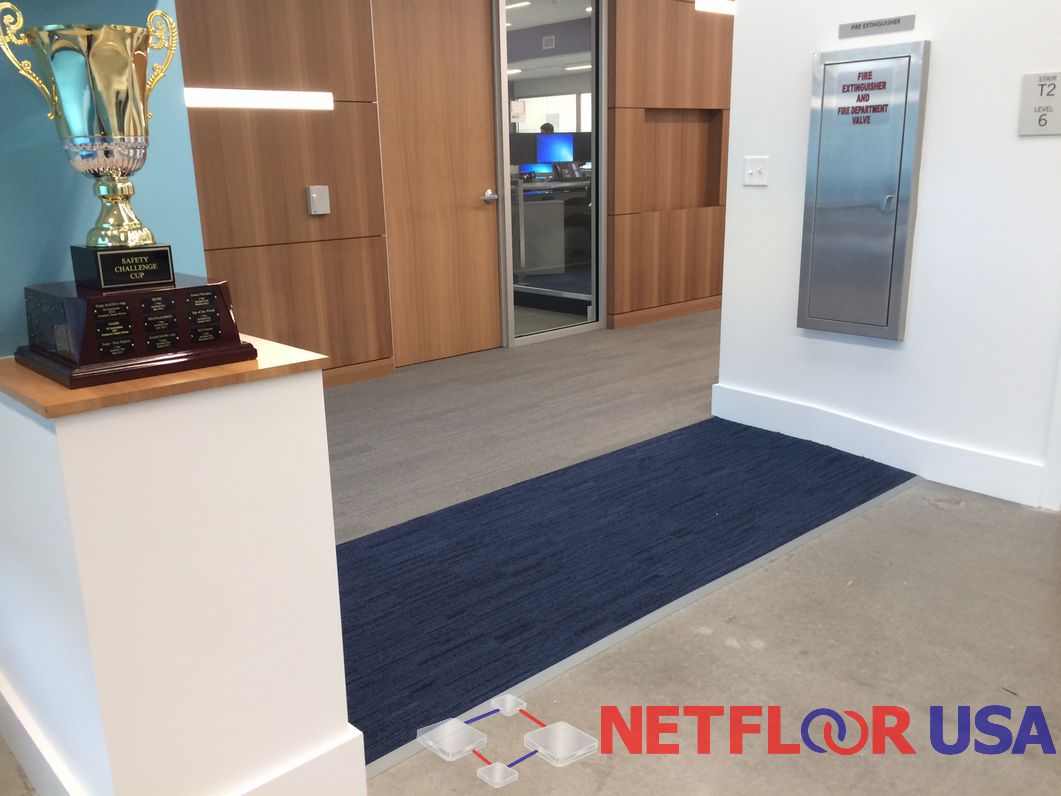
Above: Take a Quick Look; Can You Tell Where the Ramp Is?
Luckily, there are alternatives. Netfloor USA provides ramps in many shapes, sizes and even slopes. We provide our customers with ramps that have slopes of 1:12, 1:20 and even 1:40.
That means the incline is incredibly gradual. In fact, our testing shows the majority of users cannot tell they just walked up a ramp!
So, it's a ramp that really isn't. And you get bonus points because beyond a certain slope (1:20), the ADA doesn't even consider a 1:40 ramp to be a...well.. ramp!
A ramp is kind of a dirty word. Nobody in retail really wants them, because they screw up the flow of traffic. They can be a tripping hazard (if done wrong), and they take up valuable floor space.
But with our ramps, especially the 1:20 and 1:40 style, it is almost impossible to tell you are walking on a ramp. So what was once wasted space (1:12 ramp), has now become a useable part of your floor plan (1:40 ramp).
And of course, why would we stop there? By now you should know we don't just make the best damn access floors on the planet, we make them highly customizable to fit the needs of our customers.
Regardless of the ramp slope, we can do plenty of different shaped ramps from a standard ramp, curved ramps, offset ramps and even a U-shape "horseshoe" ramp.
Whatever you need for your space, we can help you get there!
Easy to Redeploy an Entire Access Floor
"Deployment" has become an overused phrase: "Deploy the technicians," "Deploy the new technology," "Deploy the forcefield!" but it still holds water. When you are managing multiple teams across a wide geographic territory, you must be confident in the direction you are taking your organization.
But still, even when you have made the smart decision (you are using cable management floor, right?) you can be faced with significant costs when you need to make changes in layout or store location.
So when you decide to include an access floor in your store design, make sure you pick the right one.
With the current trend of moving out of big box stores and into smaller, local stores with focused product offerings and high customer engagement, you and your team need to be as agile as possible.
There are plenty of reasons why you would need to move your store to a new location: upsizing, downsizing and local market trends, for example.
(We should probably remove the "downsizing" part, since you made the smart choice to use access floor, you probably don't work for a company that's downsizing. You're on the way up, baby!)
Regardless, it's nice to know that our cable management floors are not only easy to install, they're easy to reconfigure and to redeploy to a new location.
Take the CamassCrete product, for example. It's made of a strong steel and concrete panel, yet it is lighter than traditional access floor panels of similar construction. The unique pedestal system makes it easy to remove from one spot and install it in another.
But if you want easy, it doesn't get any easier than Netfloor USA ECO. ECO is a unique panel system made of high strength polypropylene. What does that mean to you? It means it's strong yet lightweight, and has a high crush strength.
Our products are so strong, you can even build walls, partitions and heavy product fixtures on them. Does this sound useful yet?
Taking up your access floor and reinstalling it somewhere else is the last thing on your mind when you are designing a new store, but isn't it nice to know that when the time comes to move, your floor will be right there with you?
A Wide Variety of Floor FInishes
So far, we've talked about how great a low profile access floor is behind the scenes. Sure, it makes cabling easier. True, it costs less to install and configure compared to other cable management methods. But what does it look like? How does it feel?
We've got you covered. Literally.
Netfloor USA has the widest range of access floor finishes in the world. From wood grain, bamboo, marble, tile, terrazzo and more, you can cover your floors with beautiful and robust finishes designed to withstand the rigors of a retail environment.
Already have corporate guidelines for floor finishes? No problem, you don't have to buy ours. Just let us know what you are planning to use, and we'll make sure it meets our thickness and wear recommendations.
At Netfloor USA, we believe in our products. We believe they are more than just raised floors; they are an integral part of your building and how you do business.
If you would like to know more about how our floors can simplify your retail store operations, give us a call or contact us. If you want more info, why not read a little more about raised access floors?
In the meantime, you do what you do best: designing and running world-class retail stores; leave the cable management to us.
Main Photo credit to Kool Cats
Access Floor,
Cable Management,
Netfloor USA CamassCrete,
Netfloor USA ECO,
Retail






 Facebook
Facebook Twitter
Twitter Google+
Google+ LinkedIn
LinkedIn